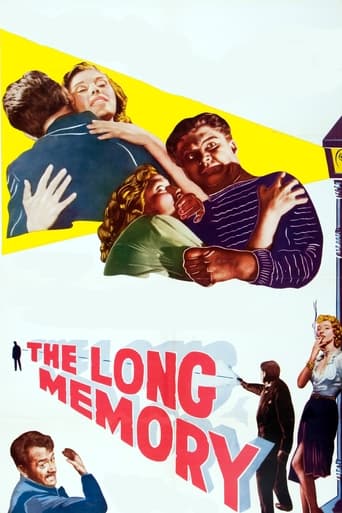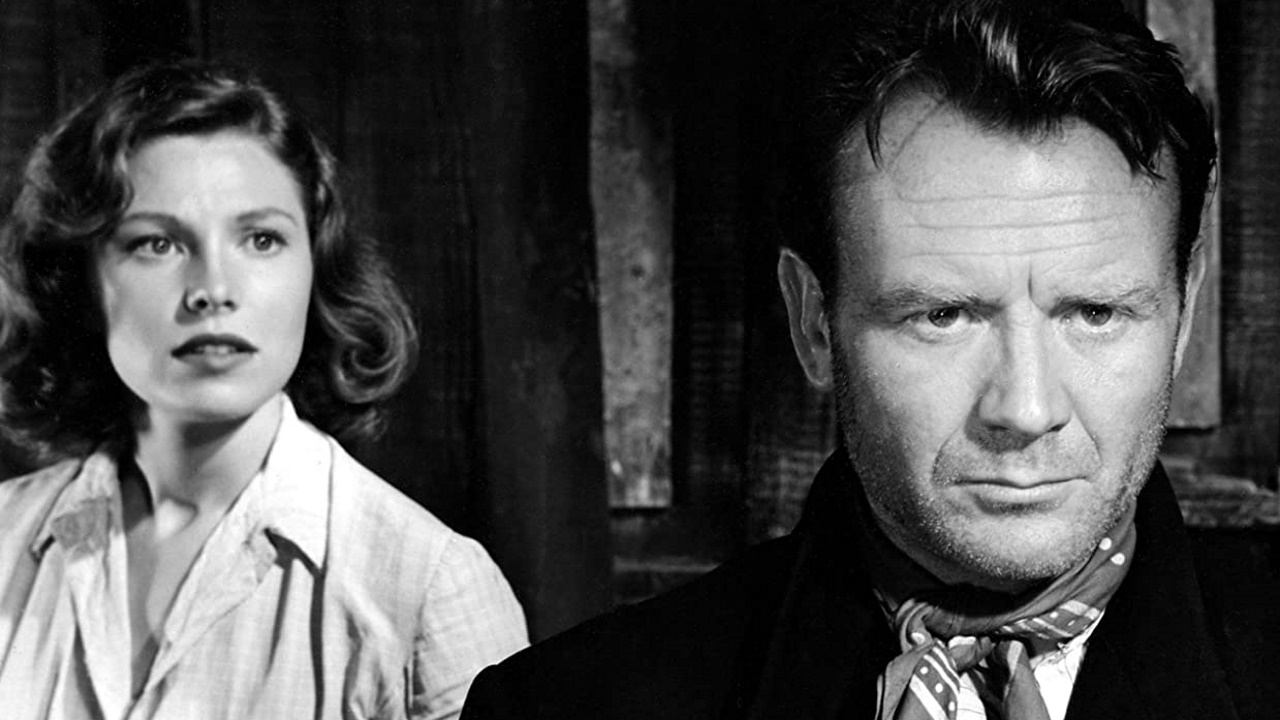Goingbegging
John Mills himself rated this one as a minor potboiler. Two things seem to deny this. One is the quality of the cast, which includes John McCallum, Geoffrey Keen, Thora Hird and Laurence Naismith, all seen at their best. The other is the quality of the IMDb reviews, a sure sign of discerning viewers either remembering this film all the way from the Fifties, or at least hearing about it.Whether or not it strictly qualifies as Film Noir, it is certainly a minor-key production, set against the grey half-world of the Thames estuary, so near and so far from metropolitan life. We linger for long minutes on the sheer barrenness of the landscape, which becomes the film's haunting theme. These were the North Kent marshes where, perhaps significantly, Dickens could often be seen walking at night, unable to sleep. A wasteland dotted with neglected little cottages, tumbledown cafés, scrap metal yards and sombre mudbanks lined with the eternal barges.It is on one of these barges, empty and abandoned beyond repair, that the Mills character has made his home after serving twelve years for a crime he didn't commit. Bent on revenge, he rejects all friendly overtures that might soften his resolve, and systematically sets out to stalk his prey.As others have commented, Mills was a less-obvious choice for this role. His sudden appearance at the front-door is supposed to paralyse his enemies with fear. Unfortunately he tries to cut a threatening figure by straining to stand as tall as he can. Being quite a small fellow, he simply looks silly in this posture, and should have learned to stare up at them menacingly from below.Then there was the matter of his accent. By this date, his wartime films were starting to be ridiculed for their unconvincing Shepperton cockney, so he wisely sticks to acting a hardened jailbird, without trying to impersonate one. Yet curiously, some other cast-members have not learned this lesson, and the falsity of the speech can sound jarringly dated.A wonderfully sinister performance by John Chandos. Also a touching scene on the barge, where Mills and a beautiful young refugee (Eva Bergh) start to compare their very different kinds of psychological baggage. Michael Martin Harvey provides the appropriate Greek chorus - and something more, as you will see - as the local ragamuffin, only slightly contrived, with a sea-shanty permanently on his lips.
James Hitchcock
Robert Hamer was not a prolific director; only around a dozen films are credited to him, and because of his serious alcohol problem there is some doubt as to the extent to which he was responsible for some of those, especially his final film, "School for Scoundrels". His career has been described as "the most serious miscarriage of talent in the postwar British cinema", yet during that relatively brief career he was responsible for some of the best British films of the forties and fifties. He is today best remembered for that brilliant Ealing comedy, "Kind Hearts and Coronets", but was capable of producing serious movies as well as comedies; his "It Always Rains on Sunday", for example, is a crime thriller showing the influence of the film noir style.With "The Long Memory" from 1952, Hamer moves even closer in the direction of noir. The plot, based on a novel by Howard Clewes, owes something to Dumas' "The Count of Monte Cristo". A young man is sentenced to imprisonment for a crime he did not commit. Upon his release, he sets out to get revenge upon those responsible for his wrongful conviction, including his treacherous fiancée. The hero, Philip Davidson spends 12 years in prison after being wrongly convicted for murder, a conviction procured by perjured evidence given by his fiancée Fay, her father Captain Driver and a man named Tim Pewsey. Fay's motive for perjuring herself was to protect her elderly father, who had become mixed up in a criminal enterprise with Pewsey and another man named Boyd, the actual murderer.Some purists maintain that film noir was an exclusively American genre, but I have never concurred with that opinion, as there were also a number of British films (and indeed French ones such as "Les Diaboliques") which share the characteristics of noir, and this is one of them. One of the classic noir features is the morally ambiguous lone male hero, and John Mills' Davidson is certainly a character of that type; had this been a Hollywood film he could have been played by Bogart or Mitchum. Although he has been the victim of a grave injustice, and in that sense has a claim on our sympathy, his experiences have made him, in many ways, an unsympathetic character, vindictive and unsociable. After his release he goes to live in a disused barge on the marshes, a dwelling reminiscent of Richard Widmark's wooden shack by the riverside in a great American noir, "Pickup on South Street". Davidson's closest friend is another of life's victims, wartime refugee named Ilse, and he has other allies in his fight to clear his name, including Craig, a journalist, and Superintendent Bob Lowther, a policeman who believes that a miscarriage of justice may have occurred. Lowther's position, however, is made difficult by the fact that he is married to Fay, the woman whose lies were responsible for Davidson's conviction.Other noir characteristics present in this film include dramatic, expressionistic black-and-white photography and a gritty urban setting, with the dingy backstreets of Gravesend (a riverside port east of London and not normally regarded as an important cinematic location) here fulfilling the role which in an American noir would played by Los Angeles or New York. The setting is not, however, exclusively urban; many scenes were shot on the North Kent Marshes, the area around Gravesend and Rochester immortalised by Dickens in "Great Expectations". This marshland landscape around the Thames and Medway Estuaries, an area which I know well, is not conventionally beautiful in the way in which, say, the Lake District or the Cotswolds are beautiful. Indeed, it can often be bleak and forbidding, but it is also powerfully atmospheric. It makes a fitting setting for this tale of crime and revenge and gives the film has a strong sense of place. The film ends with justice being done, but here too there is a note of doubt and uncertainty; it is not, for example, clear whether Lowther's marriage to Fay can survive the revelations about her past.The most famous British noir is probably "The Third Man", a British-made film even though it is set in Vienna. "The Long Memory" is less well-known, but with a strong performance from Mills in the leading role, its powerful storyline and Hamer's atmospheric direction I would place it in the same class as Carol Reed's masterpiece. 9/10
chorima75
This is not Chicago
this is postwar London. This is not Bogart
this is John Mills. This is film noir
the English way. I discovered this little known gem on TV the other day, while swapping between channels. I spent the next hour and a half glued to the screen. At first, John Mills would seem an unlikely choice for the leading role, but the film would not work without him. He perfectly portrays Davidson, a common man framed by his own girlfriend for a murder he did not commit. He is released after twelve years in prison and finds his girlfriend Fay now married to Lowthers, the policeman who investigated the case. Will Davidson seek vengeance? Or will he start a new life with Ilsa, a refugee girl he has just met? I cannot even imagine Humphrey Bogart or Robert Mitchum questioning if revenge is worthy. However, Mills possesses the innocence and fragility required to make his doubts believable. His tender relation with Ilsa is the best thing in the film. Both characters work as reflections of each other: Ilsa has been made orphan and destitute by the war, while Davidson's parents died while he was in jail. Ilsa works in a bar in the docks, where she suffers constant humiliations and abuse by the male customers. She falls for Davidson when he saves her from a rapist, and literally offers herself to him (no prizes for guessing: he is unable to resist her). We could be cynical about their motives for getting together
or we could see them as two human beings who desperately need to feel loved.One of the comments wonders why the Lowthers sleep in separate beds. The answer is censorship. Till the late 50s (this film was released in 1953), not even married couples were allowed to share a bed on screen. Davidson and Ilsa also sleep in twin beds in his tiny shack, even when a previous scene clearly suggests that they have become lovers. However, the film turns censorship to its advantage. One sequence alternatively shows both couples talking in bed. Davidson and Ilsa, the couple who are falling in love, have their beds joined at the headboard, so the camera can show them together in the same shot. Lowthers and Fay, the couple who are falling apart, have their beds separated by a bedside table, so their conversation is shown by means of alternate shots of one or the other. I totally agree that the title could not be more appropriate: this film will stay in your memory for a long time.
Ian Chapman
With its clunky dialogue, dodgy acting and funereal pace, this revenge 'thriller' would appear to have little going for it. What drags it out of the ordinary is its wonderful sense of location. This is way ahead of its time - it would be another 7 years before 'Room at the Top' ushered in that brief period of gritty social-realist dramas that would make the inner city landscape so familiar to cinema audiences. In 'The Long Memory', the desolate mudflats of the Thames estuary are used to brilliant effect to convey the spiritual desolation of Davidson, while the run-down streets and shabby domestic interiors of Gravesend vividly conjure up the dreariness of 1950s Britain.


 AD
AD


